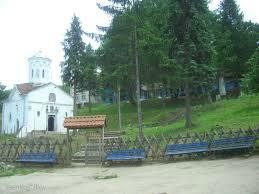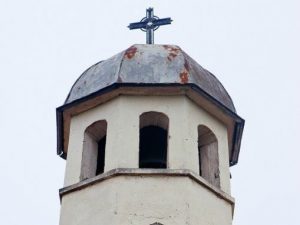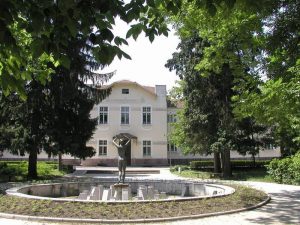

The monastery “St. Trinity” in Dobridolski is located approximately 3 kilometers south of Dobridolski village, at 22 km southwest of the town of Lom and 35 km southeast of the town of Vidin.The monastery is situated in a picturesque area with lush and varied vegetation and inhabited by a rich fauna. Monasteries forest areas have expanded, because for centuries have been donated by generous people from the nearest village, and this makes the monastery to be called Dobri Dol – the name given in gratitude. Not incidentally the area around the monastery is called Dobridol, and today is considered the most beautiful and healthy part of former district of Lomski.
The monastery is submitted to the Diocese of Vidin and thus enter in the territorial limits of the clergy district Lomski. Although it is not logical, the Dobridol monastery “Holy Trinity”, although its parish belonged to several villages from the commune of Lom, nowadays belongs to the administrative region of the Rujintsi Municipality, Vidin.
Each monastery has two names – one is marked with the saint – patron or the Christian event, which is dedicated to the monastery, and another with the place where it is settled. The first name of the monastery, from its creation to its destruction and its ultimate recovery that followed was the “Virgin Mary”, as it observes, also the famous scientist – explorer Felix Kanitz, who visited the monastery in 1868. In the last restoration of the monastery (1860) have been introduced changes in its name and it is dedicated to St. Trinity, and the name has remained to this day. According to legend, this change is due to the fact that the construction of the today’s church lasted for 50 days and was ready for “Pentecost” – the day of the Holy Trinity.
To name the monastery church, still in the remote past humans have added the name “Dobridolski” and since immemorial times the monastery was located in the village of Dobri Dol. But for unknown reasons, today is not named so, for several decades, and from the administrative point of view is broken from the settlement system, in which are the village of Dobridol and the villages in the municipality of Lom (former district Lomski) and is thus prevented and jeopardized by the interruption of relationship with the people.
It is not known when it was built and what was the fate of the monastery in the early centuries of its existence. Due to the proximity to the place where the monastery is located today, near the Roman town of Raitsariya (today. Archar), which at the beginning of the IVth century was the center of one of the first Christian communities in the provinces of Bulgaria, it was considered the precursor of the Diocese, nowadays Vidin, and here there is an assumption that, even then existed a spiritual center.
The oldest history of the monastery did not save any information, but the legend refers to its construction during the “Old Bulgarian Kingdom”, which means that it must have been in the period after the conversion of the Bulgarians in the middle of the ninth century to the fall of Bulgaria under Byzantine rule (early eleventh century.), or before the defeat of the second Bulgarian Empire at the end of the XIVth century. After the conquest of the Kingdom of Vidin in 1396, the Ottoman Turks destroyed many diocesan churches and monasteries, including the monastery of Dobridol. Then it remained in complete desolation until 1610, according to records was restored by the Rev. Pimen Zografski. Then the monastery experienced a period of ruin, after the suppression of the Chiprovtsi Uprising (1688) and finally, during the Russo-Turkish War of 1828. The restoration of the monastery was preserved in three stories:
In accordance with the first blind old man looking for his lost cow he reached to a spring. After drinking and washed his eyes with water, he could see. With the help of good Christians, the monastery it was built in this place, to protect the healing water and to provide healing to all sick people.
The second legend says that the monastery was built during the Ottoman rule of a wealthy and noble turk, who had a blind daughter. The father tried desperately to heal her, but years passed, and he always came up short. Once he met a woman “Kadan” (female), he complained to her, and she’s told him to go to the valley with large trees, “Kaynak” (springs), where his child will heal. The sad father sent the blind girl in the area and beautiful blind girl was treated with healing water from the spring, and by the providence of God and with the help and prayers of a monk from there the miracle happened – she was healed. In appreciation the Turk left two heavy bags with white coins, from which was to be built, in this place, the church. It was built in the beautiful chapel, which for many years served the healing water.
The third tradition, which is the most plausible is associated with the name of a real person – the monk Sylvester, who arrived in these parts in the spring of 1850 from the nearby monastery Izvorski. The legend tells how a shepherd lost a goat and in its search, he accidentally saw a stream with clear water, which was covered with masonry at its base. In the evening the shepherd reached home to his village and told about spring. His story was heard by the village priest, who was very old and was already a monk, named Silvesrty. After several days of sleep to Silvesrty came an old man which told him where the shepherd saw the spring near an old monastery and that there is holy water. Father Silvesrty went to that place and soon found the ruined walls of the old church. With the shepherd, about three hundred yards south of the temple, Silvesrty has seen the spring. Avid of piety, he left his home, he built a hut near the church and began to dig and to unearth the walls with his fingers. He became known in the surrounding villages and because they had no church the rich and hardworking villagers began to help the priest Silvesrty to build a new church where they could pray.
The full recovery of the Dobridol monastery occurred in Hadji with the help of the monk Venedikt, whose previous name was Basil. He was not a very educated man, but he was smart and a great patriot. With a donation, he bought the territory of the monastery, captured by Turkish princes. Step by step, were built the monastery buildings – church,the chapel over the holy spring “Saints Cosmas and Damian” two residential buildings, a tower, a fountain and commercial premises.
Evidence that the restoration of the monastery was attended by Christians from the surrounding villages who come, then, in Lomski kaaza (municipality), is the inscription written above the door of the church of the monastery, in 1860.
Further information about the construction of the monastery bears the inscription on the stone cross, lying south of the chapel “St. Cosmas and Damian.” From her we learned that the donors of the monastery were residents of the town of Lom, since 1860, and were the representatives of “Keremidchiyski esnafa.”
After the death of Venedikt (Vasil) in 1872, which was killed in a brutal way, the abbot of the monastery became a monk, Dobridol Gideon, as it is mentioned in a note from 1879, by monk Gerasim.
After the liberation of the Vidin region from Turkish domination, in (11/24/1878) the role of the monastery decreased, and a key role was played by – Dobridolski monastery, which for several decades, remained without monks. For its rebirth contributed the entry into the parish Department of Vidin in 1914, and Neophyte understood the importance of a morally monastery – religious education of the laity, and established the restoration of the monasteries. After visiting the monastery Dobridol, he sent the abbot monk Theophylact, who served in the monastery church with law and discipline. After his departure in 1924, Seraphim became the abbot monk. The following abbot of the Dobridol monastery “St. Trinity” in 1930, was the monk Antony. From 1930 to 1932 the abbot of the monastery was monk Joseph Mitchev. He took over the task to strengthen the church discipline. Then was followed by monk Ion Tsvetkov, who has served, as such, for ten years. From 1942 to 1945 Vidin Neophyte appointed Joseph Mitchev as abbot monk for the second time. After being appointed head of the leadership of the monastery, Archimandrite Kinovea Clement (1945 – 1946 AD), even if for a short time, he proved to be a good steward of the Church and is remembered as a godly man.
On 1st.VI.1946 the abbot was appointed the German monk, who in 1948 offered to Neophyte Vidin, of the Holy Synod to be raised to the rank of Archimandrite because of his merits in the service of organizing and holding the monastic monastery. For his service of half a century the old german Archimandrite was baptized in the Orthodox Christian faith. After his death on 16.III.1995 abbots of Dobridol monastery were as follows: Angel’s father (1995-2002); monk Kirill (2002-2004), Father Haralambos.
Currently, the monastery’s abbot came here on April 7th, 2009 from Bachkovo, Borislav monk, which was introduced the following year at the suggestion of Vidin’s Metropolitan Dometian with a new name – Boris. Dobridolski Hermitage was in a bad state when Archimandrite Boris has taken it, because of the careless behavior of the previous administration of the monastery. In less than two years, the monastery was radically changed and returned to the status quo ante, so the visitor can fully submerge in that special atmosphere that will lead to solitude and communion with God. The complex is a combination of a Catholic church, a chapel and residential and commercial buildings.
The ” St. Trinity” monastery is a rare phenomena in the Bulgarian Renaissance religious and artistic architecture. It belongs to the type of square type church, a basilic building with a dome octahedral built. The plan resembles to the old church of the monastery Rakovishki. The reasons why the church remained without paintings are unknown. But instead, they created more relief images of people, birds and archangels (on the western exterior wall of the temple).
Especially interesting are the frescoes on the south facade – a bull and a ram, the only of this kind in Bulgaria. Icons and iconostasis of the temple, made in 1860 have been done by masters from Debar Art School. These works made the church to be declared a cultural monument.
The chapel “St. Cosmas and Damian” built over the holy spring had the same fate as the monastery and was also destroyed and rebuilt several times. Currently, the holy water from the springs under the chapel, still continue to make wonders. Many people are healed, they come here with faith and an open heart to God. There are even cases of people who were healed, that were previously regarded by doctors as incurable patients. The healing water of the holy spring has been tested along with many sacred springs in Bulgaria (over 500) and is indexed by the International Center for Environmental Medicine.
The monastery received a gift from good Christians, two spring fountains. The oldest was built in 1861 by the guild of bakers of Lom, and resumed in 1931 by the Association of Bakers Lom and the other one was built in 1923 by the eminent citizen of Lom, Shtarbanov Elias, built in the courtyard. These two fountains are another evidence of the connection made by the Dobridol monastery with the Lom’s townspeople and the adjacent villages.
Attractions of the monastery are those three old trees towering in the monastery courtyard. They are the same trees that are mentioned in one of the stories told, about the resumption of the monastery – “..in the valley with large trees ..”.
Today, the combined efforts of the abbot of the monastery and Vidin’s Holy Bishopric are for converting the Dobridolski sanctuary in a spiritual center not only for Vidin Diocese but for the whole country. On the agenda is established the ongoing completion of the construction of the monastery’s museum. Will be exhibited some personal items that belonged to His Holiness the Bulgarian Exarch Antim I, and will host the ethnographic collections presenting the life and lifestyle of the city of Lom.The plans for future development of the Dobridol monastery include the building of a protective fence around the Monastery, as well as the repair and reconstruction of the monks rooms. To achieve these plans the monastery administration hopes to get financial support from the Rural Development Programme 2007-2013.
A significant obstacle to the smooth functioning of the monastery and an obstacle for its donors (from a purely bureaucratic reason) is the fact that the monastery is administratively detached from the municipality of Lom, and from Lom’s settlements. The abbot from Vidin sincerely hopes that the Dobridol monastery “St. Trinity” will be returned to Lom municipality.



